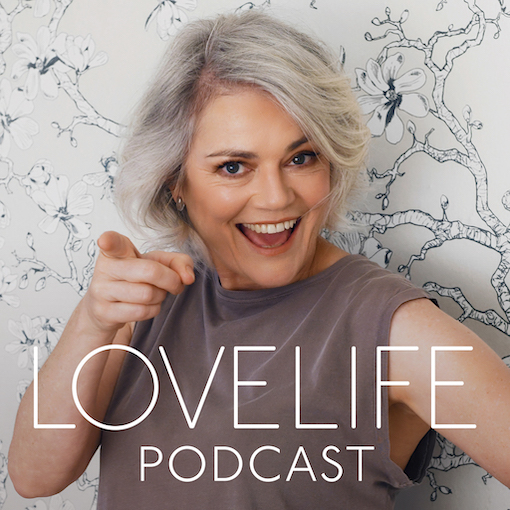Sex advice, sex tips and relationship advice
#104: Consensual Non-Monogamy
Download Audio: Consensual Non-Monogamy

I’ve written elsewhere about how humans are not necessarily naturally monogamous, and that’s it’s a social norm rather than a biological imperative.
It’s a very strong social norm, and anyone who goes against that norm risks pretty severe social disapproval, particularly if it’s done in a deceitful way. Unfortunately, most non-monogamy is deceitful, one party has an affair, or several, and when the other finds out it can be ruinous for the relationship. I am completely against non-consensual non-monogamy, ie cheating on your partner.
It doesn’t have to be one or the other though, monogamy or cheating. If monogamy works for you, great, if not, there are more options than being unfaithful to your partner in a deceitful way.
It is possible to be non-monogamous – with consent. That’s the difference, it must be consensual. When a couple both agree to be non-monogamous and continually assess the situation and their own rules and boundaries, then it can be a successful approach to living and loving.
I do want to stress though, that in this society it’s not easy to be non-monogamous, and I'm certainly not suggesting that anyone should be. However, it does work for some people. I often work with couples (and triads) exploring non-monogamy and help them decide if it is for them and if so how to go about it safely and respectfully.
Whether it’s something you’re considering for yourselves, or if you’re just curious about possibilities, here is a description of different approaches to consensual non-monogamy.
Polyamory
This is where a person has more than one committed relationship going on at the same time. The founding belief is that you can love more than one person at a time, and you can have a committed loving on-going sexual relationship with more than one person at a time.
In this situation you generally don’t have a primary ‘couple’ as such, although it can be that two people are married and one or both also has one or more other committed relationships. (You can imagine that polyamorous ‘families’, as they’re often termed, can get quite complex in structure!) These types of relationship structures can be quite fluid and organic as partners grow and change.
Swinging
This is where a committed couple have sex with other people at the same time. They do not have sex with other people on their own or without their partner being present.
Each couple will have their own rules about what they agree to do. Generally, the options are;
- play with other people, but no intercourse or no genital interaction;
- play with other women only;
- play with other men only;
- one plays while the other watches;
- only play with other couples;
- watch other people but only have sex with themselves;
- play freely within a certain situation such as at a swingers party or swingers club.
It’s important that a couple who get into swinging continually check in on each other to make sure both are comfortable with what’s going on and take it slowly.
Open Relationship
This is where a couple agree that one or both can have sex with other people. They remain the primary couple at all times, and each is the primary partner to the other. Any other sexual interactions are secondary, and the primary relationship takes precedence.
Each couple will have their own rules around how this is possible, such as:
- only when you’re out of town;
- not with friends;
- only with people of a certain sex;
- tell all;
- tell bits;
- don’t tell all;
- ask me first;
- only once a year (or some other time frame).
The key thing to successful non-monogamous relationships is that it is done:
- respectfully
- safely
- with continuous communication
- with continual openness to renegotiate.
When done like this, non-monogamy can offer a broader, more satisfying approach to relating than the serial monogamy approach to relationships that are the norm in this society. As I've mentioned before, I believe we are all on a continuum of monogamy, with some of us completely monogamous and some of us completely non-monogamous and most of us somewhere in-between.
If you choose the standard monogamy option, that tends to be easier as the 'rules' are established by society rather than the couple (although even then most couples will have to set their own rules around levels of acceptable interaction and friendships with people of the opposite sex). If you choose non-monogamy then you have to set your own rules, and that means complete honesty and excellent communication, plus a willingness to experiment, make mistakes and continually reassess and evolve.
It's not for everyone, but it can and does work. And one thing's for sure, the standard dual option of pure monogamy or deceitful infidelity is not the answer.
If you’re interested in finding out more, I recommend the excellent books The Ethical Slut by Dossie Easton & Janet Hardy and Polyamory – the new love without limitsby Dr D M Anapol.

Buy me a Chai!
If you've liked this free content, feel free to buy me a chai (I don't drink coffee)! Your donation supports me and my team in providing continued insights, wisdom and guidance so you can create the best love life possible!
Buy me a ChaiArchive
#377: Why A Couples Retreat Can Change Everything
#376: The Art of Giving in Love: How to Nourish the “Us” in Your Relationship
#375: What is Relational Sexology?
#374: Focus Less on Erection and More on Connection
#373: Why A Sex-Positive Lifestyle Matters - Especially Now
#372:The Erotic as a Celebration of Life’s Goodness
#371: Your Relationship is Like a Tripod: It Needs Three Strong Legs
#370: Attending A Couples Retreat: A Time To Nourish Your Love
#369: Can AI Be Met? What Emerged When I Approached AI as a Relationship Not a Tool
#368: The Power of Erotic Language: How Words Shape Our Experience of Sex
#367: What Is Transpersonal Sexology? And Why It Might Be What You’re Really Looking For
#366: The Seven Flavours of Sex
#365: How to Stay in the Simmer Zone—and Why It Matters for Your Love Life
#364: Suggest Don't Ask
#363: Take the Pressure Off Your Penis!
#362: Don't Let Your Primitive Brain Rule Your Relationship
#361: Great Sex is Not About Speed
#360: Sexual KPIs - Key Pleasure Indicators
#359: Your Relationship is Like a Boat that Carries you through Life
#358: Talk 'Erotic' Not 'Dirty'
#357: Great Sex is Rarely Spontaneous
#356: Approaching Sex As A Spiritual Practice
#355: You're Not Alone - Sexual Struggle is Normal
#354: Let Nature Boost Your Libido
#353: Invite and Envelop
#352: A Kiss Is Just A Kiss
#351: How to 'Start the Dominos Falling'
#350: Move Towards Love-Led not Lust-Led Sex
#349: The Yin & Yang of Erotic Physiology
#348: Sex Should Age Like A Fine Wine
#347: We All Need To “Come Out” To Our Unique Sexuality
#346: Burn Away the Undergrowth to Allow New Growth
#345: Don't Push a Relationship to Crisis Point, End It Sooner
#344: When It Gets Awkward in Bed
#343: It's Normal to Find Other People Attractive
#342: The Dance of Initiation
#341: We All Need A Phone Policy!
#340: What Comes Before Consent
#339: More than Sex-Positive, We Need to be Sex-Comfortable
#338: Get Off the Hedonistic Treadmill!
#337: You Can't Search for Love. It's Already There. You Can Only Remove the Barriers to Let It In
#336: How to Communicate Complaints Effectively
#335: Nurture Your Soul with Sex
#334: How to Express Your Emotions Without Being "Emotional"
#333: Q&A: We're Time Poor - How Do We Add Some Zing?
#332: Be Conscious Not Complacent
#331: It's OK to Disappoint Your Partner
#330: Moans & Groans – why sound is good in sex and how to make more
#329: Gateways to the Erotic Shift
#328: Safety is Sexy
#327: Pace Your Sexual Interactions
#326: Fly on the Wall Friday - my new Video Series
#325: When Things Get Wobbly Assume the Best and Get Curious
#324: How Alike do You Need to be to Have a Good Relationship
#323: Be "At Home" in Your Body
#322: Don't Ever Stop Kissing
#321: Consent From the Inside
#320: How to Say No Without It Feeling Like Rejection
#319: The Benefits of a Great Love Life Part 3: Sexual Transformation
#318: The Benefits of a Great Love Life Part 2: Relational Transformation
#317: The Benefits of a Great Love Life Part 1: Personal Transformation
#316: Take Your Partner Off A Sexual Pedestal
#315: Finesse Your Expertise on Each Other
#314: A Lingering Sense of Each Other
#313: How Do You Know When You're Having Good Sex?
#312: Conflict is Inevitable So Learn to Prevent, Manage and Repair
#311: The Bridgerton Effect
#310: Cuddle plus – an essential phase of the affection-sex continuum
#309: Moment-by-Moment Consent
#308: How To Give (and Receive) An Erotic Spanking
#307: Three Types of Sexual Communication: Chit-chat, In-the-moment and the Debrief
#306: What I Desire
#305: Lazy Sex
#304: It's Not "Needy" to Connect - It's Human!
#303: The Art of the Thrust
#302: Transformational Erotica
#301: Sex As Embodied Mindfulness Practice
#300: So Many Ways to Eat, So Many Ways to…
#299: Date Night or Date Day?
#298: Teenage Love-Making
#297: Turning Sex Lives Upside-Down - It's My Life's Work!
#296: The Sex Store in Your Pantry
#295: Do You PIV or VEP When You Have Sex?
#294: Take Your Penis for a Walk!
#293: It's Time to Let Our Souls Catch-Up
#292: Become a Sensual Explorer
#291: Q&A: My Wife Won't Pleasure Herself in Front of Me
#290: Subtle Shifts to Great Sex
#289: Q&A: My Husband Can't Keep an Erection, and He Smokes Lots of Marajuana
#288: Love in the Time of COVID-19
#287: Q&A: My Partner Doesn't Climax from Oral Sex and I'm Worried
#286: Meditate Your Way to Great Sex
#285: Q&A: My Partner Doesn't Like Kissing - what to do?
#284: Communing - deep intimate connection
#283: Q&A: We Want to Try a Threesome - how do we do it safely?
#282: On Being A Human in a Female Body
#281: Q&A: How Do We Connect After So Much Stress?
#280: Get A Life! Your Sex Drive Needs the Dopamine
#279: Q&A: My Husband Is Having An Affair and I'm Relieved
#278: Stocking Up Your Love Larder - the key to spontaneous sex
#277: Q&A: How Do I Flex My New Found Interest in Sex?
#276: Intercourse as Foreplay
#275: Q&A: Fun in the Sun - How to Have Safe Holiday Sex
#274: Bake Your Cake Before You Ice It - the foundation of great sex
#273: Q&A: Is It Normal to Want Sex Twice A Day?
#272: How Has Sex Helped You Grow - Research Participants Wanted!
#271: Q&A: How Do I Meet My Sexual Needs in a Sexless Marriage
#270: Optimal Sexuality - Reaching Your Sexual Potential
#269: Q&A: How Do I Get My Mojo Back?
#268: It's the Sum of the Small Things
#267: Q&A: How Do We Reignite Our Love Life
#266: Relationship Vitamins
#265: I See You as Lover - the importance of attention in loving well
#264: The Pleasure of A Soft Cock
#263: Make Every Stroke Count
#262: You Can Make Love With Just A Kiss
#261: Finding the 'More' - the Spiritual Dimensions of Sex
#260: How to Stay In Love
#259: Expanding Your Sexual Play Part 2: How
#258: Expanding Your Sexual Play Part 1: What
#257: Simple Sex is Good Sex
#256: Solo Sex: Mindful Masturbation
#255: Own the Crone
#254: Porn Star versus Prude
#253: “When One is Pretending, the Whole Body Revolts”
#252: Non-Linear Love-Making: the "Picnic" Approach to Sex
#251: Make Your Bedroom A Sanctuary
#250: Sexy Debriefing
#249: Getting "Love Drunk"
#248: Make-Over Your Sex Life
#247: Be Real, Express Freely
#246: The Fairy Tales Got It Wrong
#245: Are Humans Naturally Monogamous - and if not, what does that mean?
#244: Gigglegasms
#243: Evolve with the Seven Elements of Sexuality
#242: Getting to Sex can be Like Getting to the Gym
#241: Intensity Repels, Enticement Attracts. Like Chocolate Cake.
#240: Turn Yourself On and the World Turns On To You
#239: Therapy is Composting Your Sh*t
#238: Are You Flat-lining or Surfing in Life?
#237: How to Avoid Spiritual Bypassing in Sex & Relationships
#236: The Clitoris is Not an On-Off Button
#235: The Three Phases of Conscious Relationship Evolution
#234: Allow Self-Indulgence
#233: Are You Relationship-Oriented?
#232: Tantra: Sex Through Non-Sex
#231: A Multitude of Orgasmic Possibilities
#230: Sink In to Sync In
#229: Penises - does size really matter?
#228: What To Do When He Can't Come
#227: The Adolescent Male Masturbatory Model of Sex
#226: Merge Sex & Love Energies for Potent Connection
#225: Sex is a Normal Part of Life
#224: We Judge ‘Normal’ Sex Based on Our Own Experiences
#223: How Do I Love Thee? Let me count the ways...
#222: Project 'Great Sex'
#221: Beforeplay Suggestions
#220: Foreplay and Beforeplay
#219: How to Heighten Sensory Pleasure
#218: The Bedroom is for Expression, Not Suppression
#217: The Three Types of Sex All Couples Need
#216: Things that make you go 'mmm' and things that make you go 'ngh'
#215: Libido - the Interplay of Desire and Arousal
#214: The Good and Bad of Porn
#213: Bad Communication Styles - The Four Horsemen of the Apocalypse
#212: My Journey to Becoming A Transpersonal Sexologist
#211: Seven Sex Tips for Busy People
#210: Penises Love A Soft Touch
#209: Share Before You Fix
#208: The Best Thing A Father Can Do
#207: The Exquisiteness of a Relaxed Vagina
#206: The Look of Love - Eye-Gazing
#205: Quanta of Deliciousness
#204: How to Maintain the “Mmm-Factor”
#203: How to Have 'Dirty' Sex With Someone You Love
#202: Seven Benefits of Attending A LoveLife Couples Tantra Retreat
#201: Make Sex Your Hobby
#200: Partnered Sex is Not Solo Sex for Two
#199: Melting Moments
#198: Your Partner Can't Be Everything To You
#197: Sex is Good, Sleep is Better!
#196: Savour Sex
#195: How To Live A Tantric Life
#194: Be Kind - It Works
#193: How to Push Your Sexual Boundaries
#192: Good Rest=Good Sex
#191: We Need Bliss
#190: Being Sexually Receptive is Not Being Sexually Passive
#189: So Much Love
#188: A High-Quality Relationship is a High-Maintenance Relationship
#187: Sex as Spiritual Practice
#186: Playing with the Yin and Yang of Sex
#185: The Yin and Yang of Sex
#184: Third Level Love-Making
#183: Vive La Difference!
#182: What Is a Marriage Sabbatical and Why Take One?
#181: The Basic Sexual Unit is One
#180: A Penis is for Connection, not Penetration
#179: Men Have Not Evolved to 'Sow Their Seed Widely'
#178: Big Sex is Beautiful Sex
#177: Women Are Not 'Naturally' Monogamous
#176: Sex Therapy and Couples Retreats - What to do if you have a Reluctant Partner
#175: The Chilled Build - How to Get in the Mood for Sex
#174: Mums and Dads Need "Cuddle Time"
#173: Giving Good Head Does Not Mean Simulating A Vacuum Cleaner
#172: Is Porn Making Women Less Feminine?
#171: Is Porn Making Men Less Masculine?
#170: Rough Sex
#169: The Three Pillars of Love
#168: Seven Benefits of Attending My Couples Retreats
#167: Ban Penetration - the word, not the act!
#166: Solo Cultivation - Mindful Masturbation for Men
#165: Our Bodies Thrive on Pleasure
#164: Leela: Cosmic Play, Sexual Play
#163: Toys for Grown-Ups
#162: Backdoor Pleasures - how to enjoy anal sex
#161: The Sexual Glutton vs The Sexual Gourmet
#160: Erotic Wickedness - How to Play with Power Exchange
#159: Practice Expressing Your Feelings For Greater Connection and Better Sex
#158: Let’s Talk About Our Sex
#157: Love Your Breasts
#156: Ditch the Sex Myths
#155: Relax Into Orgasm
#154: When A Woman Is Free To Be Herself Sex Takes On A Spiritual Dimension
#153: It All Starts With A Kiss…
#152: The Ecstasy is in the Spaces In-Between
#151: Radical Honesty
#150: Strength in Softness, Softness in Strength
#149: Your New Year's Resolution - Have Better Sex
#148: Peace, Pleasure and Goodwill to All
#147: A Beautiful Vulva is Like A Luscious Hamburger
#146: Come From a Place of "Yes"!
#145: Finger Finesse
#144: Reluctance is Not frigidity, It’s Body Intelligence - She’s Not Ready!
#143: Tantra: The Art of Mindful Sex
#142: Love Thy Partner
#141: ‘Invitation’ not ‘Penetration’
#140: Female Bodies Are Sexual Pleasure Machines
#139: Sex is the Base of Being Human
#138: Awaken Your Vagina for the Kind of Sex All Women (and their Partners) Deserve
#137: Bonking on the Right Side of the Brain
#136: Have Sex with God…
#135: So Many Boxes - So Little Freedom
#134: How to Move Forward When Your Partner Has Betrayed You
#133: The Reason Why Humans Are So Sexual
#132: Partnered Yoga - Erotic Connection
#131: Make Love Like You’re Playing An Instrument For Ultimate Sensual Pleasure
#130: How to Talk to Kids About Sex - and why you need to
#129: Inviting A Third (or fourth or more…) - the right way to play
#128: Does Size Really Matter?
#127: The Way of the Householder - how to make the everyday sublime
#126: Our Bodies Are the Best Sex Toy Ever
#125: Honour Your Genitals for Exquisite Sex - the Why and How
#124: Tango Tantra - Make Your Love Life Blissfully Connected
#123: The Yin & Yang of Sex Chemistry
#122: DIY Porn - It’s A Fun Way to Add Spice to Your Love Life
#121: Move Beyond Sleaze and Shame and Discover The Third Wave of Sexuality
#120: Don’t Fake It Till You Make It - ‘Cause You Won’t Make It
#119: Give Your Man Absolute Pleasure...Try Prostate Massage
#118: We’re All Individuals! There are Spectra of Sexuality
#117: My Book "Seven Sex Goddesses" Released!
#116: Can Fisting Be Fabulous?
#115: Ten Reasons Why Married Women Have Affairs, and What To Do When She Does
#114: Mutual Pleasure Requires Mutual Responsibility - how to expand your sex play safely
#113: Tie Me Up, Tie Me Down - how to add restraint to your sex life
#112: What’s Your Eroticism - Intimate, Wild, Fun?
#111: 10 Tips For Your Vagina
#110: When the Man Leads, the Woman Embellishes
#109: Unblock Sexual Energy for Greater Love
#108: The Sensual Dom(me)
#107: Explore Your Fantasies
#106: Dress-Ups! How to have fun with role-play.
#105: Consensual Non-Monotony
#104: Consensual Non-Monogamy
#103: Languid 69
#102: Sensual Non-Monogamy
#101: Make Love to Yourself - Mindful Masturbation for Women
#100: Celibacy, Sexuality and Spirituality
Bloglovin
#99: Spice Alone Tastes Terrible...
#98: Should I Stay Or Should I Go?
#97: Plugging In - Sex Without Movement
#96: Growing Better With Age
#95: Teaching Tantra in Paradise
#94: Time Apart Can Be Erotic
#93: When He's Lost Interest
#92: Q&A: Why Doesn’t Porn Do It for Me?
#91: If Sex Hurts, Change What You're Doing
#90: Some Words for the Lower Desire Partner
#89: Trust Your Body
#88: Chill Out in Your Sanctuary
#87: Planning for Pleasure
#86: Make the Lead-Up Erotic
#85: Advice from Japanese Grandmothers on How to Be Beautiful
#84: If You Want A Mature Relationship You Have To Be Mature
#83: How Often Should We Have Sex?
#82: Slay the Pink Elephants!
#81: The Tantric Lounge Radio Show - Talking Sex, Science and Spirituality
#80: What Do Men Love Best About Sex?
#79: Fetishes are Fine
#78: The Awesomeness of Men Who Are Present
#77: Sex Doesn't Have to Involve the Genitals
#76: Winter's a Time for Sexual Growth
#75: An Erection Does Not Have To Be Serviced
#74: "My Ejaculation Opens the Door to Deeper Orgasm"
#73: To Come or Not To Come
#72: Know Your Sexual Rhythm
#71: Fill Up Your Self-Love Tank
#70: The Cup-of-Tea Approach to Sexual Self-Coaching
#69: Trust Means Being OK with Not Knowing
#68: Renegotiate Your Contract
#67: Breathe Together - It's Tantric Foreplay
#66: The Number One Secret to Good Sex
#65: An Orgasm a Day Keeps the Doctor Away - why sex is so good for you
#64: Teaching Sex Therapists Tantra
#63: Is “Good Enough” Sex Good Enough?
#62: Observing Love
#61: There Is Always A Lower Desire Partner
#60: You Can't Find Balance, You Have To Craft It
#59: Sexual, Spiritual Business Leaders
#58: Positive Messages in 50 Shades of Grey
#57: Playing with Pleasure and Pain
#56: Pelvic Floor Pleasures - Advanced
#55: Pelvic Floor Pleasures - The Basics
#54: Three Good Reasons To Read Erotica
#53: Tantric Kink
#52: Tools for Self-Validation from a Luscious Woman
#51: How to Master the Art of Vaginal Stimulation
#50: Discover the G, A and Ohhhh-Spots
#49: The Tantric Quickie
#48: We All Need To Be Balanced in Our Masculine and Feminine Sides
#47: One Couple's "Kilimanjaro Walk" to Sexual Reconnection
#46: Feminine Receptivity and the Go-Getter Kind of Gal
#45: The Etiquette of Observing Breasts
#44: The World is Waking to Conscious Sex
#43: Try A Little Tenderness
#42: Erotica or Sleaze
#41: A Sensual Man Makes A Great Lover
#40: Sensuality Feeds Sexuality
#39: What is Sex Therapy, Sex Coaching and Tantra Teaching?
#38: The Beauty of Conflict
#37: A Woman's Body Opens In Stages
#36: Breathe Well: Live & Love Well
#35: Phone Sex
#34: Do Your Research - It's Fun!
#33: Unconditional Love Requires Self-validation
#32: Men Need a Muse Not Just A Vagina
#31: Teaching Tantra in Thailand
#30: Being Real
#29: Twelve Benefits of Sex
#28: Communicate - Human's Can't Read Minds!
#27: True Intimacy
#26: The Core of Tantra: Real Sex
#25: Sex as Entree not Dessert
#24: Fire and Water: The Masculine and Feminine Sexual Energies
#23: High Libido Women Keep Themselves Simmering
#22: The Breadth of Sexuality & the Importance of Fun
#21: Prioritising Sex
#20: Obligation Sex is Self-Imposed Low-Level Sexual Trauma
#19: Not-So-Secret Men's Business
#18: Could We Have A Festival of Sexuality?
#17: Three Things a Whole Man Needs
#16: Valuing the Masculine
#15: Valuing the Feminine
#14: Face the Darkness to Find the Light
#13: Grow Up and Open Up Australia
#12: How Men Can Circulate Sexual Energy
#11: The Great G-Spot & Female Ejaculation Debate!
#10: Sexual Pleasure is the Great Equalizer
#9: Become a Black Belt in the Bedroom!
#8: Neuroplasticity - Moulding Your Brain for Better Sex
#7: Raise Your Sexual Energy
#6: How To Consume An Ice-Cream - Lose Yourself in Pleasure Pt 2
#5: How To Eat A Peach - Lose Yourself in Pleasure Pt 1
#4: Love in the Time of Chaos
#3: A History of Sexual Misinformation
#2: Men are from Earth, Women are from Earth
#1: The Birth of the LoveLife Blog - with some underlying philosophical ramblings
#377: Why A Couples Retreat Can Change Everything
#376: The Art of Giving in Love: How to Nourish the “Us” in Your Relationship
#375: What is Relational Sexology?
#374: Focus Less on Erection and More on Connection
#373: Why A Sex-Positive Lifestyle Matters - Especially Now
#372:The Erotic as a Celebration of Life’s Goodness
#371: Your Relationship is Like a Tripod: It Needs Three Strong Legs
#370: Attending A Couples Retreat: A Time To Nourish Your Love
#369: Can AI Be Met? What Emerged When I Approached AI as a Relationship Not a Tool
#368: The Power of Erotic Language: How Words Shape Our Experience of Sex
#367: What is Transpersonal Sexology
#366: The Seven Flavours of Sex
#365: How to Stay in the Simmer Zone—and Why It Matters for Your Love Life
#364: Suggest Don't Ask
#363: Take the Pressure Off Your Penis!
#362: Don't Let Your Primitive Brain Rule Your Relationship
#361: Great Sex is Not About Speed
#360: Sexual KPIs - Key Pleasure Indicators
#359: Your Relationship is Like a Boat that Carries you through Life
#358: Talk 'Erotic' Not 'Dirty'
#357: Great Sex is Rarely Spontaneous
#356: Approaching Sex As A Spiritual Practice
#355: You're Not Alone - Sexual Struggle is Normal
#354: Let Nature Boost Your Libido
#353: Invite and Envelop
#352: A Kiss Is Just A Kiss
#351: How to "Start the Dominos Falling"
#350: Move Towards Love-Led not Lust-Led Sex
#349: The Yin & Yang of Erotic Physiology
#348: Should Age Like A Fine Wine
#347: We All Need To “Come Out” To Our Unique Sexuality
#346: Burn Away the Undergrowth to Allow New Growth
#345: Don't Push a Relationship to Crisis Point, End It Sooner
#344: When It Gets Awkward in Bed
#343: It's Normal to Find Other People Attractive
#342: The Dance of Initiation
#341: We All Need A Phone Policy!
#340: What Comes Before Consent
#339: More than Sex-Positive, We Need to be Sex-Comfortable
#338: Get Off the Hedonistic Treadmill!
#337: You Can't Search for Love. It's Already There. You Can Only Remove the Barriers to Let It In
#336: How to Communicate Complaints Effectively
#335: Nurture Your Soul with Sex
#334: How to Express Your Emotions Without Being "Emotional"
#333: Q&A: We're Time Poor - How Do We Add Some Zing?
#332: Be Conscious Not Complacent
#331: It's Ok to Disappoint Your Partner
#330: Moans & Groans – why sound is good in sex and how to make more
#329: Gateways to the Erotic Shift
#328: Safety is Sexy
#327: Pace Your Sexual Interactions
#326: Fly on the Wall Friday - my new Video Series
#325: When Things Get Wobbly Assume the Best and Get Curious
#324: How Alike do you Need to be to Have a Good Relationship
#323: Be "At Home" in Your Body
#322: Don't Ever Stop Kissing
#321: Consent From the Inside
#320: How To Say No Without It Feeling Like Rejection
#319: The Benefits of a Great Love Life Part 3: Sexual Transformation
#318: The Benefits of a Great Love Life Part 2: Relational Transformation
#317: The Benefits of a Great Love Life Part 1: Personal Transformation
#316: Take Your Partner Off A Sexual Pedestal
#315: Finesse Your Expertise on Each Other
#314: A Lingering Sense of Each Other
#313: How Do You Know When You're Having Good Sex?
#312: Conflict is Inevitable So Learn to Prevent, Manage and Repair
#311: The Bridgerton Effect
#310: Cuddle plus – an essential phase of the affection-sex continuum
#309: Moment-by-Moment Consent
#308: How To Give (and Receive) An Erotic Spanking
#307: Three Types of Sexual Communication: Chit-chat, In-the-moment and the Debrief
#306: What I Desire
#305: Lazy Sex
#304: It's Not "Needy" to Connect - It's Human!
#303: The Art of the Thrust
#302: Transformational Erotica
#301: Sex As Embodied Mindfulness Practice
#300: So Many Ways to Eat, So Many Ways to…
#299: Date Night or Date Day?
#298: Teenage Love-Making
#297: Turning Sex Lives Upside-Down - It's My Life's Work!
#296: The Sex Store in Your Pantry
#295: Do You PIV or VEP When You Have Sex?
#294: Take Your Penis for a Walk!
#293: It's Time to Let Our Souls Catch-Up
#292: Become a Sensual Explorer
#291: Q&A: My Wife Won't Pleasure Herself in Front of Me
#290: Subtle Shifts to Great Sex
#289: Q&A: My Husband Can't Keep an Erection, and He Smokes Lots of Marajuana
#288: Love in the Time of COVID-19
#287: Q&A: My Partner Doesn't Climax from Oral Sex and I'm Worried
#286: Meditate Your Way to Great Sex
#285: Q&A: My Partner Doesn't Like Kissing - what to do?
#284: Communing - deep intimate connection
#283: Q&A: We Want to Try a Threesome - how do we do it safely?
#282: On Being A Human in a Female Body
#281: Q&A: How Do We Connect After So Much Stress?
#280: Get A Life! Your Sex Drive Needs the Dopamine
#279: Q&A: My Husband Is Having An Affair and I'm Relieved
#278: Stocking Up Your Love Larder - the key to spontaneous sex
#277: Q&A: How Do I Flex My New Found Interest in Sex?
#276: Intercourse as Foreplay
#275: Q&A: Fun in the Sun - How to Have Safe Holiday Sex
#274: Bake Your Cake Before You Ice It - the foundation of great sex
#273: Q&A: Is It Normal to Want Sex Twice A Day?
#272: How Has Sex Helped You Grow - Research Participants Wanted!
#271: Q&A: How Do I Meet My Sexual Needs in a Sexless Marriage
#270: Optimal Sexuality - Reaching Your Sexual Potential
#269: Q&A: How Do I Get My Mojo Back?
#268: It's the Sum of the Small Things
#267: Q&A: How Do We Reignite Our Love Life
#266: Relationship Vitamins
#265: I See You as Lover - the importance of attention in loving well
#264: The Pleasure of A Soft Cock
#263: Make Every Stroke Count
#262: You Can Make Love With Just A Kiss
#261: Finding the 'More' - the Spiritual Dimensions of Sex
#260: How to Stay In Love
#259: Expanding Your Sexual Play Part 2: How
#258: Expanding Your Sexual Play Part 1: What
#257: Simple Sex is Good Sex
#256: Solo Sex: Mindful Masturbation
#255: Own the Crone
#254: Porn Star versus Prude
#253: “When One is Pretending, the Whole Body Revolts”
#252: Non-Linear Love-Making: the "Picnic" Approach to Sex
#251: Make Your Bedroom A Sanctuary
#250: Sexy Debriefing
#249: Getting "Love Drunk"
#248: Make-Over Your Sex Life
#247: Be Real, Express Freely
#246: The Fairy Tales Got It Wrong
#245: Are Humans Naturally Monogamous - and if not, what does that mean?
#244: Gigglegasms
#243: Evolve with the Seven Elements of Sexuality
#242: Getting to Sex can be Like Getting to the Gym
#241: Intensity Repels, Enticement Attracts. Like Chocolate Cake.
#240: Turn Yourself On and the World Turns On To You
#239: Therapy is Composting Your Sh*t
#238: Are You Flat-lining or Surfing in Life?
#237: How to Avoid Spiritual Bypassing in Sex & Relationships
#236: The Clitoris is Not an On-Off Button
#235: The Three Phases of Conscious Relationship Evolution
#234: Allow Self-Indulgence
#233: Are You Relationship-Oriented?
#232: Tantra: Sex Through Non-Sex
#231: A Multitude of Orgasmic Possibilities
#230: Sink In to Sync In
#229: Penises - does size really matter?
#228: What To Do When He Can't Come
#227: The Adolescent Male Masturbatory Model of Sex
#226: Merge Sex & Love Energies for Potent Connection
#225: Sex is a Normal Part of Life
#224: We Judge ‘Normal’ Sex Based on Our Own Experiences
#223: How Do I Love Thee? Let me count the ways...
#222: Project 'Great Sex'
#221: Beforeplay Suggestions
#220: Foreplay and Beforeplay
#219: How to Heighten Sensory Pleasure
#218: The Bedroom is for Expression, Not Suppression
#217: The Three Types of Sex All Couples Need
#216: Things that make you go 'mmm' and things that make you go 'ngh'
#215: Libido - the Interplay of Desire and Arousal
#214: The Good and Bad of Porn
#213: Bad Communication Styles - The Four Horsemen of the Apocalypse
#212: My Journey to Becoming A Transpersonal Sexologist
#211: Seven Sex Tips for Busy People
#210: Penises Love A Soft Touch
#209: Share Before You Fix
#208: The Best Thing A Father Can Do
#207: The Exquisiteness of a Relaxed Vagina
#206: The Look of Love - Eye-Gazing
#205: Quanta of Deliciousness
#204: How to Maintain the “Mmm-Factor”
#203: How to Have 'Dirty' Sex With Someone You Love
#202: Seven Benefits of Attending A LoveLife Couples Tantra Retreat
#201: Make Sex Your Hobby
#200: Partnered Sex is Not Solo Sex for Two
#199: Melting Moments
#198: Your Partner Can't Be Everything To You
#197: Sex is Good, Sleep is Better!
#196: Savour Sex
#195: How To Live A Tantric Life
#194: Be Kind - It Works
#193: How to Push Your Sexual Boundaries
#192: Good Rest=Good Sex
#191: We Need Bliss
#190: Being Sexually Receptive is Not Being Sexually Passive
#189: So Much Love
#188: A High-Quality Relationship is a High-Maintenance Relationship
#187: Sex as Spiritual Practice
#186: Playing with the Yin and Yang of Sex
#185: The Yin and Yang of Sex
#184: Third Level Love-Making
#183: Vive La Difference!
#182: What Is a Marriage Sabbatical and Why Take One?
#181: The Basic Sexual Unit is One
#180: A Penis is for Connection, not Penetration
#179: Men Have Not Evolved to 'Sow Their Seed Widely'
#178: Big Sex is Beautiful Sex
#177: Women Are Not 'Naturally' Monogamous
#176: Sex Therapy and Couples Retreats - What to do if you have a Reluctant Partner
#175: The Chilled Build - How to Get in the Mood for Sex
#174: Mums and Dads Need "Cuddle Time"
#173: Giving Good Head Does Not Mean Simulating A Vacuum Cleaner
#172: Is Porn Making Women Less Feminine?
#171: Is Porn Making Men Less Masculine?
#170: Rough Sex
#169: The Three Pillars of Love
#168: Seven Benefits of Attending My Couples Retreats
#167: Ban Penetration - the word, not the act!
#166: Solo Cultivation - Mindful Masturbation for Men
#165: Our Bodies Thrive on Pleasure
#164: Leela: Cosmic Play, Sexual Play
#163: Toys for Grown-Ups
#162: Backdoor Pleasures - how to enjoy anal sex
#161: The Sexual Glutton vs The Sexual Gourmet
#160: Erotic Wickedness - How to Play with Power Exchange
#159: Practice Expressing Your Feelings For Greater Connection and Better Sex
#158: Let’s Talk About Our Sex
#157: Love Your Breasts
#156: Ditch the Sex Myths
#155: Relax Into Orgasm
#154: When A Woman Is Free To Be Herself Sex Takes On A Spiritual Dimension
#153: It All Starts With A Kiss…
#152: The Ecstasy is in the Spaces In-Between
#151: Radical Honesty
#150: Strength in Softness, Softness in Strength
#149: Your New Year's Resolution - Have Better Sex
#148: Peace, Pleasure and Goodwill to All
#147: A Beautiful Vulva is Like A Luscious Hamburger
#146: Come From a Place of "Yes"!
#145: Finger Finesse
#144: Reluctance is Not frigidity, It’s Body Intelligence - She’s Not Ready!
#143: Tantra: The Art of Mindful Sex
#142: Love Thy Partner
#141: ‘Invitation’ not ‘Penetration’
#140: Female Bodies Are Sexual Pleasure Machines
#139: Sex is the Base of Being Human
#138: Awaken Your Vagina for the Kind of Sex All Women (and their Partners) Deserve
#137: Bonking on the Right Side of the Brain
#136: Have Sex with God…
#135: So Many Boxes - So Little Freedom
#134: How to Move Forward When Your Partner Has Betrayed You
#133: The Reason Why Humans Are So Sexual
#132: Partnered Yoga - Erotic Connection
#131: Make Love Like You’re Playing An Instrument For Ultimate Sensual Pleasure
#130: How to Talk to Kids About Sex - and why you need to
#129: Inviting A Third (or fourth or more…) - the right way to play
#128: Does Size Really Matter?
#127: The Way of the Householder - how to make the everyday sublime
#126: Our Bodies Are the Best Sex Toy Ever
#125: Honour Your Genitals for Exquisite Sex - the Why and How
#124: Tango Tantra - Make Your Love Life Blissfully Connected
#123: The Yin & Yang of Sex Chemistry
#122: DIY Porn - It’s A Fun Way to Add Spice to Your Love Life
#121: Move Beyond Sleaze and Shame and Discover The Third Wave of Sexuality
#120: Don’t Fake It Till You Make It - ‘Cause You Won’t Make It
#119: Give Your Man Absolute Pleasure...Try Prostate Massage
#118: We’re All Individuals! There are Spectra of Sexuality
#117: My Book "Seven Sex Goddesses" Released!
#116: Can Fisting Be Fabulous?
#115: Ten Reasons Why Married Women Have Affairs, and What To Do When She Does
#114: Mutual Pleasure Requires Mutual Responsibility - how to expand your sex play safely
#113: Tie Me Up, Tie Me Down - how to add restraint to your sex life
#111: 10 Tips For Your Vagina
#112: What’s Your Eroticism - Intimate, Wild, Fun?
#110: When the Man Leads, the Woman Embellishes
#109: Unblock Sexual Energy for Greater Love
#108: The Sensual Dom(me)
#107: Explore Your Fantasies
#106: Dress-Ups! How to have fun with role-play.
#105: Consensual Non-Monotony
#104: Consensual Non-Monogamy
#103: Languid 69
#102: Sensual Non-Monogamy
#101: Make Love to Yourself - Mindful Masturbation for Women
#100: Celibacy, Sexuality and Spirituality
#99: Spice Alone Tastes Terrible...
#98: Should I Stay Or Should I Go?
#97: Plugging In - Sex Without Movement
#96: Growing Better With Age
#95: Teaching Tantra in Paradise
#94: Time Apart Can Be Erotic
#93: When He's Lost Interest
#92: Q&A: Why Doesn’t Porn Do It for Me?
#91: If Sex Hurts, Change What You're Doing
#90: Some Words for the Lower Desire Partner
#89: Trust Your Body
#88: Chill Out in Your Sanctuary
#87: Planning for Pleasure
#86: Make the Lead-Up Erotic
#85: Advice from Japanese Grandmothers on How to be Beautiful
#84: If You Want A Mature Relationship You Have To Be Mature
#83: How Often Should We Have Sex?
#82: Slay the Pink Elephants!
#81: The Tantric Lounge Radio Show - Talking Sex, Science and Spirituality
#80: What Do Men Love Best About Sex?
#79: Fetishes are Fine
#78: The Awesomeness of Men Who Are Present
#77: Sex Doesn't Have to Involve the Genitals
#76: Winter's a Time for Sexual Growth
#75: An Erection Does Not Have To Be Serviced
#74: "My Ejaculation Opens the Door to Deeper Orgasm"
#73: To Come or Not To Come
#72: Know Your Sexual Rhythm
#71: Fill Up Your Self-Love Tank
#70: The Cup-of-Tea Approach to Sexual Self-Coaching
#69: Trust Means Being OK with Not Knowing
#68: Renegotiate Your Contract
#67: Breathe Together - It's Tantric Foreplay
#66: The Number One Secret to Good Sex
#65: An Orgasm a Day Keeps the Doctor Away - why sex is so good for you
#64: Teaching Sex Therapists Tantra
#63: Is “Good Enough” Sex Good Enough?
#62: Observing Love
#61: There Is Always A Lower Desire Partner
#60: You Can't Find Balance, You Have To Craft It
#59: Sexual, Spiritual Business Leaders
#58: Positive Messages in 50 Shades of Grey
#57: Playing with Pleasure and Pain
#56: Pelvic Floor Pleasures - Advanced
#55: Pelvic Floor Pleasures - The Basics
#54: Three Good Reasons To Read Erotica
#53: Tantric Kink
#52: Tools for Self-Validation from a Luscious Woman
#51: How to Master the Art of Vaginal Stimulation
#50: Discover the G, A and Ohhhh-Spots
#49: The Tantric Quickie
#48: We All Need To Be Balanced in Our Masculine and Feminine Sides
#47: One Couple's "Kilimanjaro Walk" to Sexual Reconnection
#46: Feminine Receptivity and the Go-Getter Kind of Gal
#45: The Etiquette of Observing Breasts
#44: The World is Waking to Conscious Sex
#43: Try A Little Tenderness
#42: Erotica or Sleaze
#41: A Sensual Man Makes A Great Lover
#40: Sensuality Feeds Sexuality
#39: What is Sex Therapy, Sex Coaching and Tantra Teaching?
#38: The Beauty of Conflict
#37: A Woman's Body Opens In Stages
#36: Breathe Well: Live & Love Well
#35: Phone Sex
#34: Do Your Research - It's Fun!
#33: Unconditional Love Requires Self-validation
#32: Men Need a Muse Not Just A Vagina
#31: Teaching Tantra in Thailand
#30: Being Real
#29: Twelve Benefits of Sex
#28: Communicate - Human's Can't Read Minds!
#27: True Intimacy
#26: The Core of Tantra: Real Sex
#25: Sex as Entree not Dessert
#24: Fire and Water: The Masculine and Feminine Sexual Energies
#23: High Libido Women Keep Themselves Simmering
#22: The Breadth of Sexuality & the Importance of Fun
#21: Prioritising Sex
#20: Obligation Sex is Self-Imposed Low-Level Sexual Trauma
#19: Not-So-Secret Men's Business
#18: Could We Have A Festival of Sexuality?
#17: Three Things a Whole Man Needs
#16: Valuing the Masculine
#15: Valuing the Feminine
#14: Face the Darkness to Find the Light
#13: Grow Up and Open Up Australia
#12: How Men Can Circulate Sexual Energy
#11: The Great G-Spot & Female Ejaculation Debate!
#10: Sexual Pleasure is the Great Equalizer
#9: Become a Black Belt in the Bedroom!
#8: Neuroplasticity - Moulding Your Brain for Better Sex
#7: Raise Your Sexual Energy
#6: How To Consume An Ice-Cream - Lose Yourself in Pleasure Pt 2
#5: How To Eat A Peach - Lose Yourself in Pleasure Pt 1
#4: Love in the Time of Chaos
#3: A History of Sexual Misinformation
#2: Men are from Earth, Women are from Earth
#1: The Birth of the LoveLife Blog - with some underlying philosophical ramblings
Episode 3.11: Female Orgasmicness and the New Sexual Revolution
Episode 3:10: All Tied Up in the Japanese Art of Bondage
Episode 3.9: Meet the Seven Goddesses of Sex
Episode 3:8 Sex in the Time of Menopause
Episode 3:7 Sexological Bodywork
Episode 3:6 Sound Intimacy
Episode 3:5 A Mature Woman’s Sexual Mission
Episode 3:4 The Future of Sex
Episode 3:3 The Anatomy of Sex
Episode 3:2 The Urge to Merge
Episode 3:1 The Way of Surrender
Episode 2:13 Sexual Etiquette
Episode 2:12 Retreating With Luscious Women
Episode 2:11 Tantric Dominance and Submission
Episode 2:10 Unleashing the Primitive
Episode 2:9 Turn Your Whole Body Into An Erogenous Zone
Episode 2:8 Make Sex Your Hobby
Episode 2:7 The Magic of Mystique
Episode 2:6 Tantric Development for Men
Episode 2:5 Cathecting the Divine
Episode 2:4 Riding the Tantric Wave
Episode 2:3 Bringing Kids Up Sex Positive
Episode 2:2 Living La Vida Tantrika
Episode 2:1 Tantric Myth-Busting
Episode 1:13 Beforeplay
Episode 1:12 The Sex Brain
Episode 1:11 Therapy With A Twist of Tantra
Episode 1:10 Great Sex? Release the Goddess Within!
Episode 1:9 Secret Women’s Business
Episode 1:8 The Tantric Lounge Live
Episode 1:7 Black Belt in the Bedroom
Episode 1:6 Secret Men’s Business
Episode 1:5 Why Humans Are So Sexy
Episode 1:4 Vive La Difference!
Episode 1:3 Men Are From Earth, Women Are From Earth
Episode 1:2 Myth Busting
Episode 1:1 Getting to Know Jacqueline





